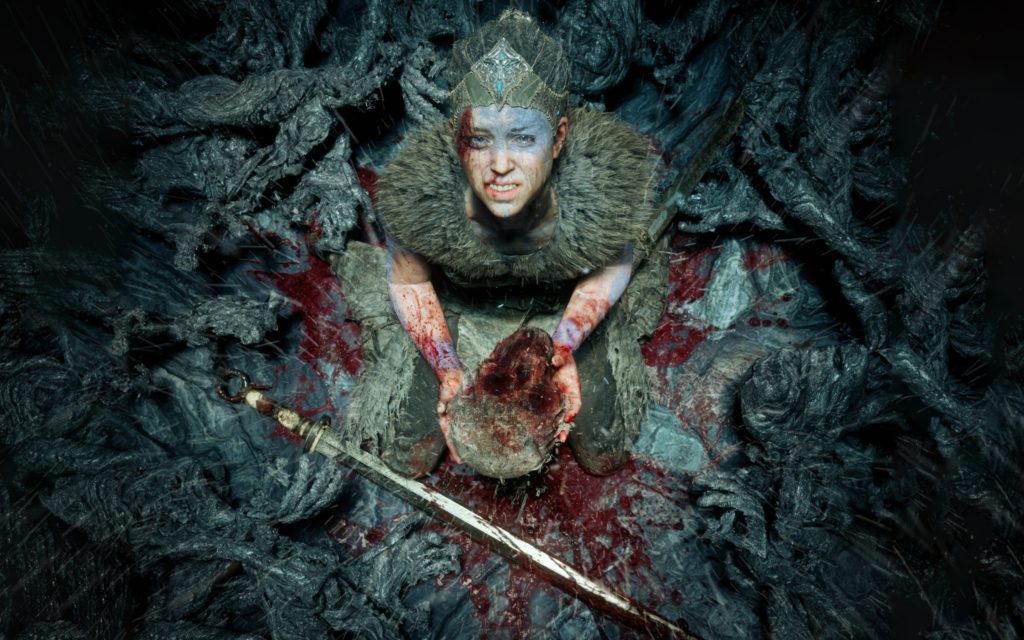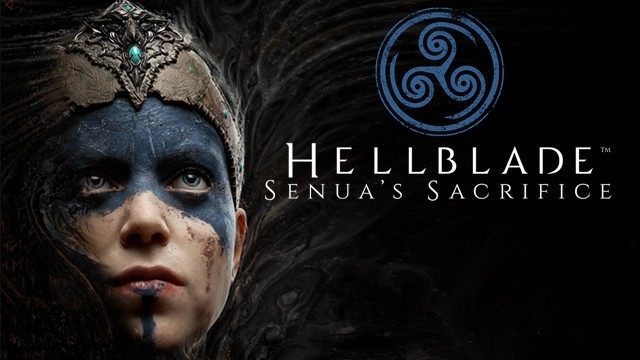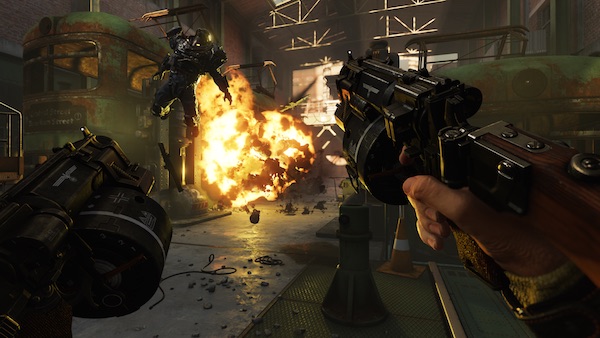Hellblade: Senuas Sacrifice – Battles fought in the mind.
Hellblade: Senua’s Sacrifice, developed by Ninja Theory, is hands down the darkest game I have ever played. Its uses modern technology and amazing voice work in order to not only produce an enjoyable and fun game, but also to convey their confronting theme: how terrifying one’s mind can be and how one woman struggles to deal with her breaking psyche.
The game focuses around Senua, a Celtic warrior on a quest to Hell to save her beloved’s soul. It sounds pretty generic, you think, until a disclaimer pops up and says:
‘The following contains realistic depictions of psychosis. Experts psychologists as well as people who have experienced psychosis have assisted in the making of these depictions. Some may find this disturbing, especially if you have experienced similar symptoms yourself.’
 When the game finally loads up, you begin to hear voices in your headset. Gossip and taunts coming from all directions as several voices bitterly converse. Converse about you.
When the game finally loads up, you begin to hear voices in your headset. Gossip and taunts coming from all directions as several voices bitterly converse. Converse about you.
This chatter is continuous throughout the game, utilizing binaural sound technology to make the voices feel like their self-generated, which is a fancy way of saying that the game makes you feel like your legitimately hearing voices. The voices say many, many things, taunting you during a difficult puzzle, and motivating you during boss fights.
But no matter what they are saying to you, that white noise is ever present.
Then, the trippy cinematics start. You see your main character begin losing a grip on what is real, with her nightmares merging with reality and dark, swirling hallucinations begin filling the screen.
This is what is going on in your protagonist’s head, for Senua suffers from psychosis, and by the time you, the player, pick up the story, Senua is in the middle of a full mental breakdown.
As the disclaimer states, the developers have created a game that contains some of the most realistic depictions of psychotic symptoms to date, but the real kicker is that you get to experience a tastes of what it is like.
This, I believe, is the game’s greatest achievement. After extensive research with the help of psychologists and people who actually suffer from psychosis, NInja Theory managed to pull off one of the most realistic depictions of a severe mental disorder that can be safely experienced by the player. Their main engine for this idea is the audible and verbal hallucinations.
This dev diary where the developers interview several people how have psychosis in order to get an idea of what they must recreate in Hellblade.
After interviewing several people who experience auditory verbal hallucinations, the developers opted to make each voice their own entity, with distinct personalities that usually represent whatever Senua is (and in some cases what you are) thinking and feeling.
Clearly the developers wanted these voices to be ‘main characters’, and wanted the player to be able to recognize each voice as their own entity, similar to how some real suffers do. So, they gave Senua very little dialogue and made sure she went on her quest alone, meaning for most of the game, there was only you and the deafening silence of the wilds. I found this very disconcerting because the majority of video games that I’ve played have tonnes of dialogue or background music or even another NPC (non playable character) to keep you company. But in Hellblade, Ninja Theory rids you of these things, leaving you with no one, other than the voices. They were the only thing to break the silence, so you listened to them, desperate for company. You started to trust some and hate others. You felt irritated when they taunted you, but motivated when they encouraged you. You start to heed their warnings and trust their judgements of situations. The game reminds you that these voices are merely figments of Senua’s imagination, but didn’t stop me from feeling a little more reassured every time they spoke up.
This reassurance in the voices and the loneliness of the game are all things that actual suffers told the developers the experienced. They described how having such a severe illness that has huge amounts of stigma makes them feel isolated, with one other than the voices in their head to keep them company. So the devs reflected this in their game, striving to make the player feel lonely and isolated in the gamescape, while giving making the voices seem like their own entities so the player can project much-needed companionship onto.

Ninja Theory wanted to make a game that tackled the sensitive issue of severe mental health issues, and did so using a medium that allowed the player to be immersed in the experience, which I think is why it worked so well. In other media like film for example, mental health is glorified or used as a story device (like plot twists) in order to avoid the social stigma that surrounds the issue, but these types of uses lose most of their impact on the audience. But Hellblade is unique, because it is a playable story, where the player is put in the shoes of the character, meaning that the devs of the game could make the player experience a taste of what it is like to have psychosis. But they didn’t stop there.
The developers not only wanted to make a realistic psychosis experience, but they wanted to show how much stigma and fear surrounds these severe mental health issues.
It is no mistake that Hellblade is set during the Norse time period, a period where science was replaced with magic and myths, and practices such as psychology were non-existent. These people explained psychological disorders through magic and curses, but had no idea what they actually were, let alone how to deal with or treat them. In Hellblade, you discover that Senua had been struggling with psychosis years before the events of the game, and her father kept her locked up in their home and was forbidden to leave. It is then explained that he did this not because he wanted her to get better, but because he and the rest of her village thought that she was cursed and that some sort of darkness was eating her mind.
When Senua was with her to-be husband Dillian, she was terrified of spreading her curse to him, and even set out on another quest to face the Darkness she and everyone else believed had infected her.
As you play the game, one of Senua’s voices describes these quests, almost like a narrator shedding more light on Senua’s past. This voice describes how our protagonist attempted to face down the Darkness as if it were a demon, and how it almost consumed her. Now, there is a little evidence of some kind of black magic working against Senau sprinkled throughout the game, one example being the enemies you have to battle against during combat sections, but I believe that this darkness that the narrating voice talks about is in fact Senua’s psychosis, and shows how she really has no idea what is happening to her, and in turn is defaulting to what she does understand; curses and black magic.
I think the devs made these location and backstory choices because of what the real life sufferers that interviewed felt about their illness. Psychosis, as well as other similar disorders, feel like the work of black magic. The hallucinations and voices feeling so real and so terrible, that they couldn’t possibly be self-generated. They must be the work of some dark force working against them, just as Senua believes. But of course, this is not true. The hallucinations and the voices and all the terror that comes with it is the work of one’s mind.
As I progress further and further through the game, I’m beginning to question if any of what is happening is real, because as the game goes on, I’m beginning to notice that Senua’s mental state is rapidly declining. She is really losing it, and some of the game’s segments are proving me right. Below is a link to one of these segments. It is a puzzle that comes right after Senua enters an abandoned warehouse and learns of how a devastating fire killed everyone inside. Then, Senua starts to hallucinate, and all of a sudden you are forced to navigate a maze of wood and hook while being pursued by a wall of fire. Other than the timing of the puzzle and the new screaming voices of those who were killed, the main reason I think this is in Senua’s head is if you get too close to the fire, your view and sight literally starts to fracture.
Being an indie (independent) developer, Ninja Theory needed to create a game that would get them noticed amongst the gaming community’s heavyweights, and the best way they found to do that was to do something that had never been done before: create a game where the player can be fully immersed inside of the protagonist’s breaking mind. They made a game that not only raised awareness about mental health, but also shed light on how some people understand and handle it as well as how far we have come in the study of mental health.
But if it were to be summed it up in one sentence, I think Senua put it best: ‘The hardest battles are fought in the mind.’
This video put together by Ninja Theory outlining how people reacted to their game. This video really sums up why I feel Hellblade is such an incredible game.




